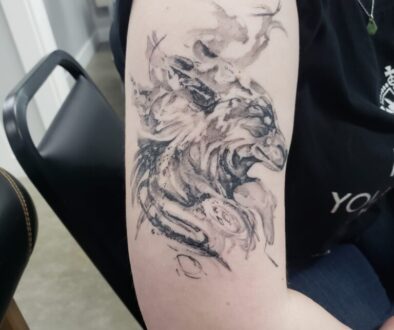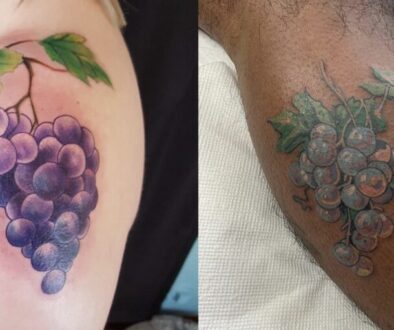How To Prepare The Skin So You Can Apply a Tattoo Stencil
|
Listen to this Article::
|
Most tattoo designs are applied to the skin using a stencil. Using a stencil ensures a quality transfer of the premade design. Rather than committing to a drawn-on design, the tattoo stencil allows clients to pick t perfect spot for their tattoo because they can easily be readjusted.
If you are expecting a new tattoo, you should know how this process goes. It can save you time at the studio and empower you to speak up so you get the design you dreamed of.

Table of Contents
What You Need to Apply a Tattoo Stencil
Stencil application is an art form. Like most artists, you need the proper tools to get the job done. Here is a list of what you need to get started:
- Transfer paper* – or – Tracing paper and a hectograph pencil
- Branded stencil lotion*, Green Soap, or another product that can be used for the transfer.
- 1 Razor
- 70% USP Alcohol
- Antimicrobial soap
- Paper towels
- Medical history and allergy list of the person getting the stencil placed on them.
- Hand sanitizer**
- Distilled water
**Hand sanitizer is used to clean your hands and take off the stencil if it gets stuck into the skin. More on that below.
First, You Need a Design to Transfer.
Before doing any tattoo, you need a design. Get busy designing a tattoo on paper or a digital tablet. Make sure you have linework drafted up to use for the transfer. Make the design fully and trace the outline. You can also create the outline first, make a copy, and then do whatever shading or color you want on the copy.

Transfer Your Design to a Useable Stencil
If you have a stencil transfer machine, use it.
If you have transfer paper but no machine to do the transfer for you, it’s time to draw. Take your linework and place it directly on the purple/red/green transfer sheet. Use a ballpoint pen to trace the design, pressing hard enough to pick up the transfer paper ink. Be careful not to press so hard you rip the paper.
If you don’t have a stencil transfer machine or transfer paper, you will have to old school it with a hectograph pencil. Take your design and flip it over. Use a lightboard to see the design through the back and trace the outline with a hectograph pencil. If you don’t have a lightboard, take your design to a window and trace it using ambient light.
Prepping the Skin for a Tattoo Stencil.
Now that you have your design printed onto a usable stencil, you must prep the skin. Do a patch test on every person before applying any products/tattoos to their skin.
Before you start, put on a pair of disposable gloves.
First, clean the area where the tattoo stencil will be placed. Do this first with antimicrobial soap. Products like Hibiclens will ensure the skin won’t get infected if appropriately used. Leave the cleanser on for a few minutes to work after giving the skin a good scrub. Rinse the skin with distilled water and dry with a paper towel.
Using soapy water (tattoo shops often use a product like Green Soap), shave the area to remove any hair. Hair will block the transfer paper from coming into contact with the skin, so removing it is always necessary – even peach fuzz can interrupt a transfer! Apply with a soaked paper towel, then dry.

Next, clean the skin with 70% alcohol. This removes extra oils that can block the absorption of the stencil ink. It also dries out the skin so more of the transfer lotion can be absorbed into the skin. Pour the alcohol onto a paper towel and wipe down the area where the tattoo stencil will be placed.
Placing the Stencil.
To ensure the stencil gets transferred to the skin, you need to apply a product to the skin that makes that happen. Branded products, bacteriostatic, Green Soap, or other products all work well to transfer a stencil to the skin.
If you are using deodorant like Speed Stick, cut the entire stick into small pieces and store them separately in small baggies. Remember, hygiene is essential, so don’t use the same piece on multiple people!
Use enough of your transfer lotion/soap/deodorant/branded product to moisten the skin. Any excess should be easily absorbed into the skin while you rub the area where the stencil will be placed. Pat any excess off the skin with a dry paper towel.
Keep rubbing the area until the skin feels *tacky* or dries out. If the skin is dry, repeat this process until you can feel a bit of grip on your disposable gloves.

Once the skin is tacky, place the tattoo stencil onto the skin where the design is supposed to go. Press it firmly onto the skin for around 10-30 seconds (longer if it is a bit wet). Leave the stencil on the skin for a few minutes. Make sure the person getting it doesn’t move.
Removing the Stencil.
After waiting a minute or two, peel the stencil off the skin. Start at a corner and peel the paper backward over itself slowly. Be sure NOT to wiggle or twist the stencil as you remove it because the design can get smeared.
Let the transfer sit for 10-15 minutes after removing the stencil paper to ensure it gets absorbed into the skin.
Tips for Stencil Placement.
- If the design you are using needs to be moved, use alcohol to remove the design.
- For stubborn transfers that won’t leave the skin, use alcohol-based hand sanitizer to remove the residuals. Hand sanitizer evaporates slower than plain alcohol. This allows the product to stay in contact with the skin longer, increasing the desiccating effects, which removes more ink from dyed skin.
- For rounded parts of the body like shoulders, you may have difficulty getting the stencil paper to sit straight. Putting relief cuts along the design can help contour the stencil paper to challenging areas (Video coming soon)
- For large designs, use multiple pieces of stencil paper to make one big stencil. Or you can only apply focal points to a transfer and free draw the rest of the design on a person.
Problems With Tattoo Stencil Placement and How to Fix Them.
- If your tattoo smears, it’s probably because there was too much transfer lotion on the skin. Remove the stencil and wash the skin with alcohol again before trying to replace it.
- If you don’t have bold, legible lines, the skin wasn’t wet enough to pick up the transfer. Clean the skin again and apply more transfer products than before to get a usable stencil onto the skin.
- If the person getting the stencil placed on them has very dry skin, moisturize before putting the stencil. Using products like A&D ointment or Vaseline can help. Just rub an oil-based product into the skin, let it sit for 10 minutes, then repeat the cleaning directions above before placing the stencil.
- If you can’t remove the stencil with alcohol or hand sanitizer, you need to moisturize the skin before trying again. Use the same steps for dry skin to take the previous tattoo stencil out of the skin.
*If you want to know what is in stencil lotions and transfer paper, read our article about what is in them.




